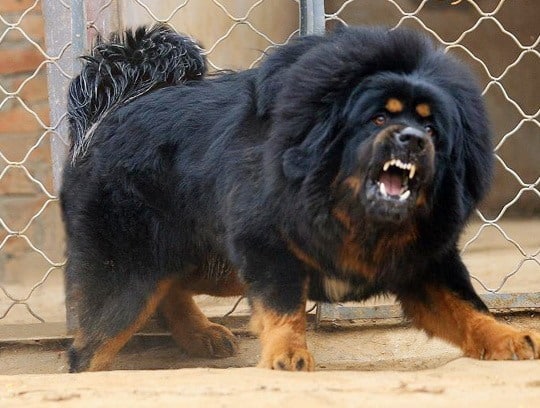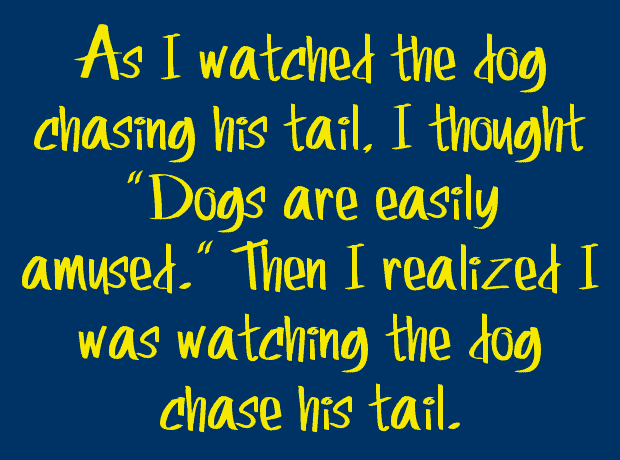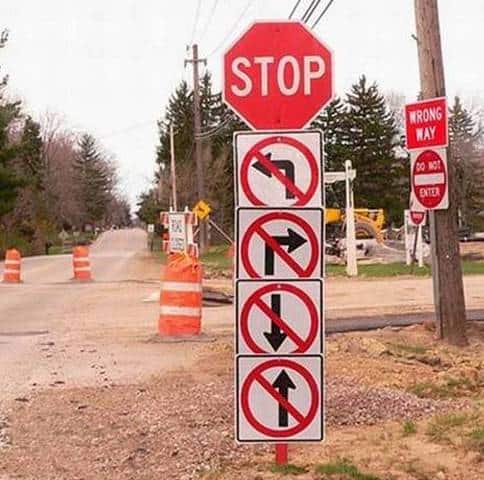We’ve all seen those (allegedly) aggressive dogs, who often start to become reactive as soon as they’ve seen another dog. The closer they come, the worse it becomes. Get close enough, and some are growling, thrashing, and trying to lunge at the other dog. They seem to have lost all control.
I’ll look here at the extremes in training. A brief look at the simple punishment approach, then far more detail with the allegedly-scientific positive force-free stuff. To discuss that I’ll visit two dog behavior blogs, one by dog trainer Victoria Stilwell, and a fairly popular blog I’ve visited for many years now, called Eileen and Dogs by Eileen Anderson.
Eileen was quite unusual, as a person who started with little knowledge of dog behavior, but read and explored over eight years, to where she seems quite comfortable discussing and analyzing the topic. Along the way, however, she may have studied the trees so well as to lose sight of the forest.
Comes first the Punishment
As people often tend to extremes, one common approach to aggression is to start teaching the dog to be quiet and ignore any distractions. To do this we snugly fit the shock collar on his neck and start to slowly bring him near another dog. Each time he just begins to show a reaction, press hard on that button.

All of which makes it much easier to walk him around the neighborhood, and since he has you, he really doesn’t need other dogs, does he? Or, you can take him to meet other dogs with similar training, and watch them all just calmly walk around, maybe avoiding eye contact.
What they’re doing is mainly suppressing behaviors they don’t like, and forcing attention on demand. Often using far more force than is needed, in order to have a faster response and less need to spend time learning about behavior. There are a few trainers who use a newer and lower level shock collar, with somewhat different methods. But so few that it’s difficult to assess them, and the majority still appear to be using the old methods. All of this and its variations are pretty simple.
Now comes Force-Free, the mushy side
At the other extreme from punishment, you could follow somebody like Victoria Stilwell, who tells you that aggressive training breeds aggressive dogs. She says the dogs cease to use warning signs and instead cope with their fear with aggression, while a confident dog doesn’t feel the need to do so. Looking at Eileen’s blog, we see similarly that aggression begets aggression, and that it’s just that simple.
Well, the dogs I just described above with punishment will pretty much back away, showing aggression only if they feel trapped. Wait…what about all that begetting of aggression? Maybe, there’s a bit more involved, and it does not always happen that way? Maybe, if it was really the way that Stilwell and Eileen describe, that nobody in their right mind would ever use a shock collar. But, that is not what happens.
Stilwell said that the underlying causes are pretty constant, with insecurity, fear, and anxiety. I find that fascinating because I see those as only symptoms and I then look to treat the underlying causes. If a dog is anxious or fearful, there’s pretty likely some reason for that (but I might be getting too scientific here?).
All too often, the treatment prescribed for modifying aggression in dogs misdiagnoses the root cause of the aggression, resulting in dominance and punishment-based protocols techniques and training tools which actually make the problem worse.
I had to read that one twice to make sure I got it right. I understand Stilwell likes to rant against punishment, but why should people who are mistaking the reason for the issue result in them using punishment, as opposed to anything else in the world that’s possible to use?
At its core, aggressive behavior addresses the dog’s need to increase distance from a perceived danger.
However, a response to perceived danger is one of flight, fight, or freeze (with both dogs and people). The real increase in the distance between them likely comes from the flight choice, and there’s not usually much time to aggress while running away. And if the dog freezes, not much happens unless the other dog approaches further. Since she’s now missed on two out of three choices, something is apparently lacking with her explanation here.
Now, if a dog sees another dog but is scared of approaching him, why on earth would he walk over to him? Perhaps, just perhaps, dogs might be social animals who want to meet other dogs. But if they’ve rarely done so before and lack social skills, they don’t know what to expect or how to behave. That’s enough to make anybody nervous! Get nervous enough, and you may get aggressive. And at that point, you’re faced with those three simple choices. Fortunately, most dogs choose flight or freeze (but again I might be getting too scientific here?).
Why is there aggression?
Stilwell, on aggression
Then Stilwell gives the dog’s motivation for aggression,
Although aggressive behavior is an effective way for dogs to control their environment, affect behavior in others, ensure priority access to resources, and achieve reproductive success, using the dog’s supposed desire to be the “alpha” to explain why dogs aggress does not do justice to what is really going on in the dog’s mind.
Earlier she said aggression is to increase distance, now she says it allows dogs to control their environment. But, if you could really do the latter, why would you need to increase distance? And, just maybe, some of what she thinks is aggression is actually agnostic behavior designed to reduce fighting? (But I might be getting too scientific here?)

If a dog is aggressing towards you, it is more likely to be because he is fearful or is protecting something that is important to him and NOT because he wants to be higher than you in the “pack.”
The pack idea is based on outdated theory that misunderstands a dog’s social intentions.
A more accurate explanation lies in the fact that if a dog has not been taught how to function successfully in a domestic environment, he will behave the only way he knows how.
Your dog may control access to food, space, furniture, or other things that provide comfort and pleasure by aggressing, but this is more likely done out of fear that he will lose access to those resources and not because he wants to be ‘above’ everyone else in the household.
While she does seem to realize dog pack theory is wrong (not just outdated, but actually incorrect), she claims the dog might be protecting something that is important to him. Let’s just think about that one for a moment. He’s not likely trying to protect a toy from damage, as few people are likely to chew up his toys. As for protecting something to ensure his access to it, that comes under resource guarding. Something quite common in scared dogs that never learned to share, but often one of the easiest things to handle in training.
She seems to get close enough to almost tickle the truth, but it’s simply the lack of social skills and not any specific domestic environment that’s involved. I’ve worked with pack ferals, who grew up outside, knowing only dogs, and who had no trouble at all in sharing with me, as they had already learned that with other dogs. But the dogs who lack any social skills will simply be afraid and indicate that. It’s not that that’s the only way they know, but instead that they don’t know any way to handle the situation.
Aggression is deeply rooted in the dog’s instinctual need for safety.
Yup, and equally in cats, lizards, and humans. There’s not really a point here.
Growling, snapping, lunging, and biting are critical ways the dog uses to communicate his intent. That intent may be to warn, intimidate, resolve conflict, increase distance, defend, or cause harm. In any case, aggression is designed to ensure the dog’s personal safety and survival.
Whoa, that’s a whole bunch of purposes there! Except, she forgot things like play, and just giving a simple message. Not to mention agonistic behaviors and mamas teaching young pups. So some of this is just like people when talking and waving their arms, only it comes out as growls and lunging. By Stilwell only linking these behaviors to aggression, she does all dogs a great disservice.
My dog may do all of those things while initially training a pup. In fact, he has done it with dozens of pups that he trained. At the dog park, some of the young ones he knows will run over and bug him to provoke a good-natured growl and lunge, knowing he’d never hurt them and that it’s only a fun game.
Helping an aggressive dog become more confident by teaching him to see a perceived threat or potential loss of a valued resource in a different light is the key to successfully changing the behavior.
To see things in a different light tends to imply changing their emotional impact. However, that has nothing to do with behavioral psychology, which deals only with actions and not emotions (that darned science again!). So, if you instead taught the dog the social skills needed to manage and share resources, and how to interact with other dogs so as to resolve conflicts, the end result there would likely be that emotional change. But that’s the result and not the cause.
Eileen, on aggression
Turning back to Eileen, she brings in operant aggression.
Two of the most common side effects of attempting to use pain or other punishment on an animal are called “operant aggression” and “redirected aggression” (Azrin, Holz, 1966). In operant aggression, the dog attempts to stop the aversive stimulus by aggressing against the individual who is delivering it. For example, you jerk the dog’s collar; the dog bites you. In elicited aggression, the dog aggresses against nearby individuals who may have had nothing to do with the punishment. For example: you jerk the dog’s collar; the dog bites your child.
Well, let’s just take the collar jerk example. The way we see some people walking their dogs, you’d think there would be some operant aggression there! Yet, even with very abused dogs, who I know were beaten with a stick and had severe and often open wounds, there was no such aggression happening. Yes, what she said is surely possible and does increase the likelihood of aggression. And, yes, this can be demonstrated in a research study. But, no, this is not so very common in the real world and is very dependent on other factors that are not mentioned.
And notice the somewhat odd terminology here. You jerk the dog’s collar and the dog biting you she calls redirected aggression. Doesn’t that imply that the dog doesn’t realize you are the one actually doing this, so that direct aggression would then be the dog biting his own collar? And while the dog biting somebody not involved is normally called redirected aggression, but here she calls it elicited aggression. A common type of confusion when citing a particular paper and using only their own definitions.
A recent study found a correlation between behavioral euthanasia of dogs and the owners’ use of punishment.
However, I spent many years with shelters and rescues. The single, biggest predictor of behavioral euthanasia was the dog’s lack of social skills. I’ve seen many beaten dogs who came around in weeks, but the badly neglected dogs could take months. And some of those showed such a high degree of fear aggression that they didn’t last very long at a municipal shelter.
And there’s also another possible explanation for that correlation she cites. Start with the average person, having a dog, and a perceived behavior problem. Over time, they may try several different approaches to resolving the issue. If each attempt fails, as they become more and more frustrated, the subsequent attempts will tend to be more assertive and aggressive in nature, often utilizing greater degrees of punishment or force. We can exclude people who are experienced in dealing with these issues, and those people who will never become very assertive, no matter what happens or how long it takes. However, in my opinion, that leaves a very large number of people remaining who will end up using aggressive punishment before they finally have the dog euthanized.
Many of those cases are then not directly due to punishment, but instead to the chronic training failures. From my experiences over many years, I feel that’s far more likely than her explanation.
Eileen, on using positive reinforcement
As for how to actually use that positive reinforcement,
A qualified behavior consultant will … perform a functional assessment, which has as its goals the determination of the function and antecedents of the aggressive behavior. When does it happen and what does the dog get out of it? She will almost never need to see or provoke the actual aggression to treat it.
Like most anything else that’s reasonable, this can work for many situations. But a large number of aggression issues are due to the dog’s inability to cope with a situation that he may desire or cannot avoid. To resolve this, the dog must learn acceptable and effective behaviors for coping with (not avoiding!) the situation.
For instance, if you always panic when in the water, you cannot learn to swim by avoiding the water, no matter what the functional assessment comes out with. And that’s true even if you have to show a bit of panic at times.
I’ve taken certain highly aggressive dogs to the other side of a fence from well-known dogs, where they all start fence-running, displaying all the ferocious aggression signs that they can imagine. After a few minutes I have her pause for a few seconds, then go back at it. Before long, she is pausing on command, stepping back to take a rest, then when I tell her to go she may resume running. Very soon, however, this lady who couldn’t come anywhere near another dog is very calmly walking along the fence and gently saying hello to her new friends.
She has started to learn how to control herself when excited, and that it’s now safe and familiar to walk over and sniff her new friends.
Often after months of getting nowhere with a dog trainer, many dogs respond within a half-dozen sessions, often only a few. At that point, most of them are ready to go in and directly meet their new friends, and ready to learn new social skills, but without all the previous fear that plagued them and previously prevented learning.
Looking back to that last quote, I did exactly what Eileen said to avoid, and I deliberately provoked all of the aggression, albeit in a controlled manner that satisfied the dog’s need. At that point, her new friends taught her social skills, using various methods including something called positive reinforcement. And none of the functional assessment antecedents were ever needed, nor did they now exist!
A caveat here is that the use of this method depends on the results of a behavioral assessment, which demonstrates what the dog needs and how the dog will respond to various stimuli (current learned behaviors). A simple sentence that, one day, I may take many pages to explain. Obviously, this is not suitable for certain aggression issues, but nor is any other single solution.
Eileen’s own operant aggression
Here’s another example of “operant aggression” that happened in my own household. I used to have a very benevolent shepherd mix, and at the same time a feisty rat terrier mix. The terrier, Gabriel, would get in Shadow’s face every day. Shadow was three times Gabriel’s size and weight. When they ran somewhere, Gabriel would leap and snap at Shadow’s neck. Shadow put up with this for years. Then one day he had had enough and bit Gabriel. The bite was inhibited, but it was still serious enough for a vet trip. If the bite had been to a toddler, that might have been the end of Shadow’s life. I always think of Shadow when someone says, “He’s so sweet; he puts up with so much from the other dogs.”
This was a very simple case of social skills deficits and the resulting bad manners. Applying a term like operant aggression to this is like describing a single branch, and claiming that defines the tree. If little Gabriel had tried that with any of my training dogs, that behavior would have been extinguished within a few days. But Shadow lacked the social skills to manage it. Unfortunately, this was a common three-way deficit, as neither of the dogs nor the owner knew how to resolve this, or even that it was a poor and aversive situation, which could and should have been changed long ago.
The other point here is the tendency for some people to try to describe a situation using some technical behavioral terminology which only describes a small component, and present that little bit as though it explains all or is the most important factor. Over the years, I stopped following Eileen as that tendency seemed to become predominant.
What’s wrong with Positive Reinforcement?
Positive reinforcement is the most effective philosophy to use in these cases, because the methods have a lasting impact, even on so-called ‘red zone’ dogs.
Victoria Stilwell
From the very definition of Positive Reinforcement (+R), it will be far more efficient in persuading a dog to do something, then in having him not do something. The typical red zone dogs already have an acquired learned behavior involving high reactivity and often aggression. Part of the training must therefore teach them not to do this and +R is a very poor choice there. In reading from various blogs where people report failures using reward training, by far the majority of cases are with using +R to stop some behavior.
Yes, that can be done with something called counterconditioning, but that involves more complexity, and the needed scenarios may sometimes be difficult to arrange. But Stilwell doesn’t seem alone here, as Eileen posted Why Red Zone Dogs Need Positive Reinforcement Training, where her reason for using +R is just:
Training with pain, startle, and intimidation carries huge risks. Decades of science tell us that aggression begets aggression. It’s that simple.
eileenanddogs.com
So I wonder if I’m missing something here? If the entire range of possibilities only consists of +R at one end, and all the punishment and pain at the other, isn’t it even remotely possible that there’s something in the middle? We all know there’s a great distance between those two, so how come all these people trying to give us all this advice are woefully ignorant of that?

In my opinion, any really competent dog behaviorist could train two dogs using similar aggression and punishment techniques and intentionally have one be aggressive with people, while the other dog is not. Within just those two simple words, there is a world of variations. More importantly, the same can apply to two people following the same directions with their dog, as the focus on only +R does not really manage all of the interchanges.
From one perspective, both Stilwell and Eileen seem to be cherry-picking simple examples with emotional appeals and making black-and-white comparisons. And they are not deterred by the fact that their extremes rarely occur in nature, because if zero is the minimum and 10,000 the maximum, you are far less likely to ever see either of those two end numbers, but those are the ones they focus upon.
The Operant Family (Quadrants)
From another perspective, positive reinforcement is only one out of four types of operant conditioning (sometimes called the operant quadrants). They are all part of life and learning, and all of them play a part in nearly all complex scenarios. But, Eileen’s comment on training with pain might refer to 99.9% positive punishment, with Stilwell’s target being 99.9% positive reinforcement. However, either one is quite impossible for any trainer to maintain, so it has very limited meaning in any reality. The four types of operant behavior are:
- positive reinforcement
- negative reinforcement
- positive punishment
- negative punishment
In brief, positive and negative just mean adding or removing something. And reinforcement and punishment mean that the behavior is more or less likely to happen in the future. In that vein, the reinforcement and punishment actually apply to the behavior, and not the dog. When speaking about positive reinforcement, these are the actual definitions that apply.
Let’s say, after the dog did a behavior that you liked, you gave him a piece of paper that he chewed, then spit out. If that resulted (for some weird reason?) in that behavior being more likely to occur in the future, then this was positive reinforcement. Yes, it may sound a bit twisty, but you can find this in the references, and both Stilwell and Eileen claim to be knowledgeable enough to teach you about this.
In the same paragraph they often mix operant reinforcement with conventional punishment, and trying to paint operant punishment as the same thing, although they should well know of the differences.
Stop with the extremes, already!
Instead of all this, why don’t we just vary the type and intensity of the four operant components as the training progresses? Say I start with a scared dog running up to me, then stopping and growling as he gets too close. So I use a gentle and calm voice, together with a steady stop hand in front of him, to have the dog slow up before he gets too close. I get him to calm down at a distance comfortable for him and only allow him to slowly approach as he seems ready to handle it, and only for short periods.

As the period he can tolerate becomes longer, I slowly add other simple activities for him. Typically, I accomplish in about 20 minutes what takes days or weeks for only positive reinforcement, which may not work at all for this issue. From the definitions of the four operant quadrants, try and pick the one(s) I was using here.
The comparison of this against watching a +R trainer at work is dramatic. If you really focus on the detail, and define aversives only by the dog’s own responses, you will often find the +R trainer may be causing more discomfort for the dog.
Why was my approach better? Because the dog didn’t know what to do, and I effectively and efficiently communicated to him acceptable behaviors that would satisfy his interest while also reducing his anxiety and making him feel better. Once the dog learned these behaviors and understood this, his continuing this behavior was then positively self-reinforced, a much more persistent type of +R than anything they described. However, +R was not what I started with. To put my approach in more descriptive terms, I used communication and compassionate teaching.
Two other components of learning also contributed here. One is repetition, as early sessions are very short, and in those typical 20 minutes, the dog may go through a dozen or more attempts at approaching me. The other is that no food is involved, so the dog is never distracted from the focus of the training. So here I described a number of different components, instead of Stilwell’s use of only +R.
Now, for dogs who become aggressive on your approach but do not have enough interest in you for them to approach, the method is quite different, and uses respondent (classical) reward conditioning, instead of operant conditioning. I believe this is a very important distinction, which I never see Stilwell or Eileen making, but you’ll hear it from experts in this field like Jean Donaldson.
Punishing with punishment
And the other day I punished several dogs. I walked up to one and called her name while staring and pointing at her. She immediately calmed down and was less likely to repeat that (for now at least). Another dog I smacked on her 100# butt, and she let the toy go and backed up into me for a butt scratch. With another dog I loudly said “no”, and another received a severe leash correction, as I jiggled the leash three times, instead of only twice. All of these are classed as aversives, which the Force-Free camp claim are never to be used.
And the punishment I applied was quite different than anything ever considered by Stilwell or Eileen but was based on the LIMA Principal, (endorsed by the IAABC and others) in choosing the method being Least Intrusive and Minimally Aversive. Stilwell and Eileen seem to only see punishment as beating the dog with a stick, yet they both claim to be experts in operant conditioning, and that has a very specific definition of punishment. Sure, you could use the common meaning for punishment, but if you’re speaking of positive reinforcement then you cannot keep changing the meaning of punishment without saying so, and they never say.
Some punishment examples are both common and operant, while others are not. Pointing at a dog while saying “no” is only operant punishment if the targeted behavior decreases. We simply do not have good terminology to use here, so additional explanations are always needed.
For Force-Free, the same issue applies with force. My dog reaches the end of the leash and is restrained by force. A woman at a pet food store nudged her dog with her foot, and another woman started yelling at her for abusing the animal. When the loud woman didn’t stop yelling, they had to ask her to leave. As she walked out of the store, her poor dog was dragged and yanked off his feet by the leash. Both women here used force, but there is a real difference here that Stilwell and Eileen seem to ignore.
As I indicated here, no two people really have the same definitions for force-free or aversives. And punishment already has two quite different definitions. And for some things I’ve seen many people taking perceived intent into account, instead of the dog’s reaction, in assigning their labels. So if two people do the same thing to a dog, but one is wearing a mean face at the time, perhaps that makes up most of the difference to some people?
The End of Aggression
I’ve shown some of the mistakes in using extremes, adding the most common reasons for dog aggression, and how to deal with them. I pointed out that positive reinforcement (+R) is only a tool and not a full solution, and that every tool around has its limits. And the examples I gave showed that some frequent writers on dog behavior simply do not understand either of these concepts. That when looking at some of their comments and rules in detail, their logic just falls apart.
My intent was to show that avoiding situations and issues solves nothing. That effective communication and compassionate teaching will realistically deal with most aggression issues. But that managing this can be quite difficult, and that you may need more help than just following some article.
With many of the reactive and aggressive dogs I’ve worked with, very often the undesired reactive behavior changes to use acceptable rules and becomes self-reinforcing for the dog. And we then call that play.
